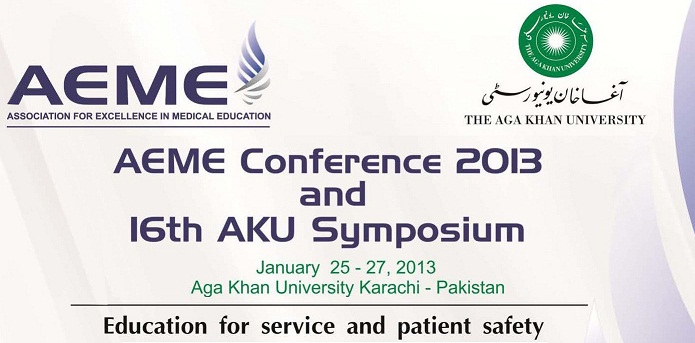Day 1 : Poster Presentations (Theme: Education for Service)
College to faculty: proposal for integration of medical education institutions in universities
Location
Auditorium Pond Side
Start Date
26-1-2013 3:30 PM
Abstract
Background: Majority of public sector medical education institutions in Pakistan works under the supervision of Ministry of Health while public sector universities take necessary directives from Higher Education Commission. This institutional dichotomy leads to a deficit in deliverance of comprehensive medication education. Teaching of basic sciences as well as non-clinical subjects (community medicine in particular) is examination orientated. Moreover, in the absence of a coherent research environment the diagnostic and interventional facilities available in hospitals fail to contribute adequately to research. Contrary to this, a medical faculty working in collaboration with other life sciences faculties (such as pharmacology, veterinary and animal sciences, food sciences, chemistry and physiology) and social sciences (such as psychology and statistics) will produce graduates better equipped with knowledge of research methodology and practices (Miles, S., Price, G. M., Swift, L. et al, 2010). The proposed model will also help develop a liaison of medical faculty with apparently distant faculties like physics and environmental sciences in order to develop newer technologies of diagnosis and treatment as well as discover environmental influences on disease and recovery processes (Chandra, A., 2012). Improved competence in statistical analysis and interpretation of data will not only help future doctors envisage better projects, it will also enable them to compete at international level. Funding opportunities from international donors will also be increased for medical projects due to improvement in human resource availability for research purpose. A research masters program for post-graduate medical trainees will make them clinicians capable of reading changes in dynamics of their outdoors and indoors and report it. Conversely, preventive health may be better explained to the youth in rest of the faculties in routine as well as in cases of an epidemic.
College to faculty: proposal for integration of medical education institutions in universities
Auditorium Pond Side
Background: Majority of public sector medical education institutions in Pakistan works under the supervision of Ministry of Health while public sector universities take necessary directives from Higher Education Commission. This institutional dichotomy leads to a deficit in deliverance of comprehensive medication education. Teaching of basic sciences as well as non-clinical subjects (community medicine in particular) is examination orientated. Moreover, in the absence of a coherent research environment the diagnostic and interventional facilities available in hospitals fail to contribute adequately to research. Contrary to this, a medical faculty working in collaboration with other life sciences faculties (such as pharmacology, veterinary and animal sciences, food sciences, chemistry and physiology) and social sciences (such as psychology and statistics) will produce graduates better equipped with knowledge of research methodology and practices (Miles, S., Price, G. M., Swift, L. et al, 2010). The proposed model will also help develop a liaison of medical faculty with apparently distant faculties like physics and environmental sciences in order to develop newer technologies of diagnosis and treatment as well as discover environmental influences on disease and recovery processes (Chandra, A., 2012). Improved competence in statistical analysis and interpretation of data will not only help future doctors envisage better projects, it will also enable them to compete at international level. Funding opportunities from international donors will also be increased for medical projects due to improvement in human resource availability for research purpose. A research masters program for post-graduate medical trainees will make them clinicians capable of reading changes in dynamics of their outdoors and indoors and report it. Conversely, preventive health may be better explained to the youth in rest of the faculties in routine as well as in cases of an epidemic.

